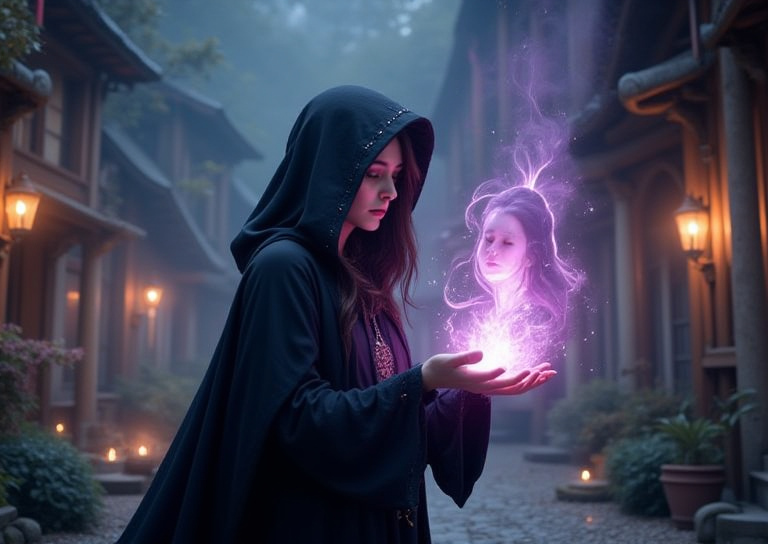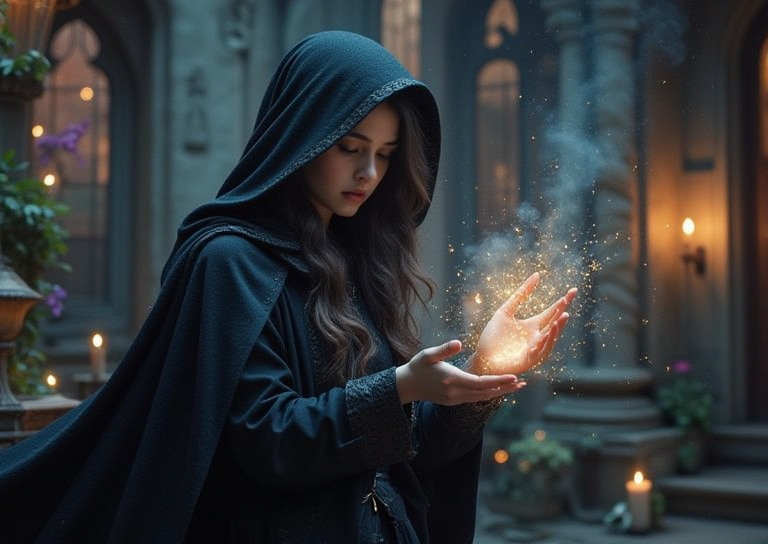
Necromancy, often misunderstood and shrouded in mystery, is a magical practice that involves connecting with the spirits of the dead. Unlike pop culture depictions, necromancy isn’t just about raising the dead or controlling spirits—it’s about respecting and learning from those who have passed. For centuries, necromancers have sought knowledge, guidance, and power from the spirit world, and this practice is deeply woven into the histories of witchcraft, divination, and ritual work.
In this article, we’ll journey through what necromancy is, a bit of its history, and how it fits into modern witchcraft. We’ll also touch on a few spells and rituals you can try yourself if you’re drawn to work with the spirits.
What is Necromancy?

At its core, necromancy means communicating with spirits, typically of the dead, to gain insights, knowledge, or even assistance with earthly matters. While necromancy was once feared and misunderstood, today, many witches see it as another way to connect with the spirit world. For most practitioners, necromancy isn’t about dark magic or forcing spirits to act against their will. Instead, it’s a way to open a respectful dialogue with those who have crossed over, allowing for deeper wisdom and understanding.
Necromancy can manifest in various forms, from simple rituals that honor ancestors to more elaborate ceremonies that involve specific tools or even visiting sacred places associated with the dead. It’s all about making connections, opening portals of communication, and treading carefully in a realm that demands respect.
A Brief History of Necromancy

Necromancy has ancient roots in many cultures. The Greeks and Romans practiced it, with necromancers often venturing to dark, hidden caves believed to be entrances to the underworld. Ancient Egyptians engaged in ceremonies to communicate with their ancestors, while many African and Afro-Caribbean spiritual traditions also honor spirits of the departed.
In the Middle Ages, however, necromancy was heavily demonized by the church. The fear of death and the dead turned it into a forbidden practice, often equated with black magic. Those who practiced necromancy were accused of heresy or worse. Despite this, the art has persisted and evolved, moving from dark corners into the open, where it’s seen as a powerful yet cautious craft.
Necromancy Today: What Does it Look Like?

Modern necromancy has shed a lot of the darkness associated with it, focusing instead on ancestor veneration, spirit communication, and psychic exploration. Today’s practitioners might use tools like spirit boards, candles, bones, and sacred herbs to call upon spirits. Some necromancers prefer to work alone in quiet spaces, while others find strength in community rituals.
Necromancers today use this practice for:
- Gaining Insight: Spirits can offer valuable perspectives, especially for big decisions.
- Healing and Closure: Connecting with departed loved ones can offer closure, helping to resolve feelings of loss or regret.
- Strengthening Spiritual Ties: For witches, necromancy can help in building a deeper relationship with the spirit world, ancestors, and guides.
The Ethics of Necromancy: Respecting the Spirits

If you’re thinking about trying necromancy, know that respect is the most crucial part. Many spirits are willing to communicate, but they demand courtesy. It’s essential to approach each ritual with gratitude and an open mind, understanding that spirits aren’t always going to answer, and that’s okay.
Always approach necromancy with clear intentions. Never call upon spirits for petty reasons or entertainment. Spirits may not respond kindly to being summoned without purpose, and in some cases, may ignore the summoner altogether.
Necromantic Tools and Supplies

To get started, here are a few simple yet powerful tools often used in necromancy:
- Black or White Candles: Black symbolizes protection and banishing, while white is for purity and light. These colors help set the tone and maintain safety in spirit work.
- Spirit Board: Also known as a talking board, a spirit board can help facilitate communication. Be careful—if you use a spirit board, make sure to open and close the session respectfully.
- Bones and Stones: Certain bones, like chicken bones or small animal skulls, can serve as symbols to connect with the dead, as can stones like onyx or obsidian for protection.
- Herbs and Incense: Mugwort, wormwood, and frankincense are traditional herbs associated with spirit work. They help raise energies and create an inviting atmosphere for spirits.
Simple Necromancy Rituals and Spells

Here are some easy, respectful rituals for beginners. Each of these is a small step into the realm of necromancy. Remember to approach with a clear mind, pure intentions, and gratitude.
1. Ancestor Candle Ritual
Purpose: To connect with an ancestor for guidance or support.
- What You’ll Need:
- A black or white candle
- A photo or small memento of the ancestor
- Mugwort or lavender incense
- Instructions:
- Set up your space by dimming the lights and lighting your candle. Place the photo or memento nearby.
- Say aloud, “I call upon the spirit of (name). With respect and honor, I seek your guidance. Please come forth if you are willing.”
- Take a few deep breaths, relaxing into the energy. If you feel a presence, you may ask for guidance or simply sit and listen.
- When you’re finished, say, “Thank you, (name). I release you with gratitude and peace.” Blow out the candle to close the session.
2. Dream of the Departed Spell
Purpose: To invite messages from a spirit in your dreams.
- What You’ll Need:
- A small sachet bag
- Dried mugwort or lavender
- A clear quartz crystal
- Instructions:
- Place the dried herbs and crystal into the sachet. Hold it in your hands, saying, “I invite the spirits of wisdom and kindness to visit me in my dreams. With open heart and mind, I ask for your presence.”
- Tuck the sachet under your pillow before going to sleep.
- In the morning, write down any dreams or messages you received. You may repeat this spell as often as you wish.
3. Spirit Offering Ritual
Purpose: To honor spirits, creating a bond without expecting anything in return.
- What You’ll Need:
- Fresh flowers, a small bowl of milk, or honey
- A white candle
- Instructions:
- Place the offering on your altar or in a quiet outdoor space. Light the candle and say, “To the spirits who have gone before me, I offer these gifts in gratitude. May you be at peace and know you are honored.”
- Let the candle burn for a few moments, then snuff it out.
- Leave the offering out overnight and discard it respectfully in the morning (preferably by returning it to the earth).
4. Mirror of Memories Ritual
Purpose: To communicate with a spirit, receiving messages through a reflective surface like a mirror.
- What You’ll Need:
- A hand mirror or any mirror you can comfortably hold
- A small black or white candle
- A piece of cloth to cover the mirror when not in use
- Instructions:
- Begin by cleansing your mirror, wiping it with a cloth dipped in a bit of salt water to clear any previous energy.
- In a dimly lit space, light your candle and sit in front of the mirror. Hold it gently, close to your face.
- Gaze into the mirror, letting your vision soften as you say, “Mirror of memories, reveal the unseen. May the spirit (name, if known) come forth and speak through the veil.”
- Allow yourself to relax. Sometimes, you may see images, symbols, or feel impressions rather than words.
- When you’re ready to end the session, thank the spirit and say, “With gratitude, I close this portal.” Cover the mirror with the cloth and store it safely.
5. Spirit Key Spell
Purpose: To open a safe, temporary gateway for a spirit to communicate with you in a specific space, such as an altar.
- What You’ll Need:
- A small key (preferably one you don’t need for other uses)
- White chalk
- Salt
- A white candle
- Instructions:
- Choose a quiet space where you feel comfortable. Sprinkle a small circle of salt on the ground or your altar and set the key in the center.
- Draw a protective circle around yourself with chalk or visualize one, while holding the candle in front of you.
- As you light the candle, say, “With this key, I open a gateway. Spirits of light and peace, if you wish to communicate, I invite you here.”
- Hold the key in your hand and close your eyes, breathing deeply. Be open to any messages or feelings that come to you.
- When you’re ready, say, “I close this gateway with gratitude and peace.” Blow out the candle and place the key in a safe place, only using it for this purpose in the future.
6. The Night Wind Whisper Ritual
Purpose: To receive guidance or answers from the spirits of the air or any spirit that might wish to communicate subtly.
- What You’ll Need:
- A small bell
- A feather (optional but helpful for connection to the air element)
- An open outdoor space or a window
- Instructions:
- Go outside on a night with a light breeze, or stand near an open window where you can feel the wind.
- Hold the feather and bell in your hands. Ring the bell softly three times, calling, “Spirits of the night wind, I seek your wisdom. If you carry messages or answers, let them come.”
- Stand still, letting the wind guide your thoughts. Focus on any impressions you get—ideas, words, or sensations that might seem out of the ordinary.
- When you feel ready to end the ritual, ring the bell once more and say, “Thank you, spirits of the night wind, for sharing your whispers.” Close your window or leave the space, grounding yourself by touching the earth or a nearby tree.
Common Questions About Necromancy

1. Is Necromancy Dangerous?
Like any magical practice, necromancy requires caution and respect. Spirits are individuals, and not all are friendly. However, with careful intention-setting, protection methods, and a respectful approach, necromancy is as safe as any other form of magic.
2. Can Anyone Practice Necromancy?
Yes, anyone can learn necromancy with patience and respect. It’s not an art that should be taken lightly, though. Familiarize yourself with protective practices first, and don’t rush into any rituals without a clear purpose.
3. How Do I Know a Spirit Has Contacted Me?
Spirits can communicate in many ways, including sudden thoughts, chills, or even auditory messages. Pay attention to subtle shifts in energy, physical sensations, or emotions that seem to appear out of nowhere.
Final Thoughts: Honoring the Dead with Humility
Necromancy, when practiced with integrity, is a sacred and powerful connection with the spirit realm. It invites us to step beyond our everyday concerns and recognize that life, death, and the spiritual realms are deeply intertwined.
Approach necromancy not as a way to control or conquer, but as a path of listening and respect. May your journey be one of gentle discovery, honoring those who came before while uncovering the wisdom they’re willing to share.




